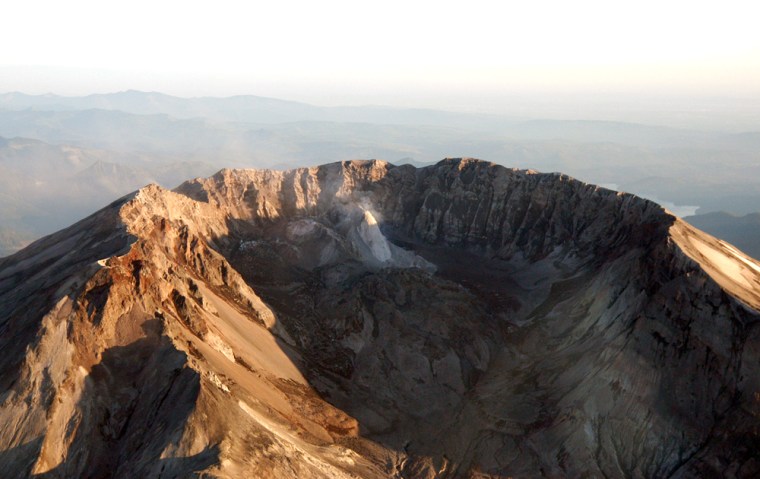There's a whole lotta shakin' going on at Mount St. Helens these days as the restless peak does what it has done for thousands of years: build new lava domes that totter and fall and become the foundations for still more new ones.
A series of unusually strong earthquakes — exceeding magnitude 3 — has been reported in recent days by the Cascades Volcano Laboratory in Vancouver, Wash., about 50 miles south of the mountain. The latest was a magnitude 3.1 quake early Thursday that was accompanied by a rockfall.
Rockfalls during the quakes send up plumes of ash. Some tower thousands of feet above the 8,364-foot crater rim; a March plume reached 30,000 feet, raising concerns about area air traffic. Some plumes don't escape the crater and some wispy, gritty puffs crest just above the rim.
The recent stronger quakes are related to rockfall from the mountain's towering, unstable new dome, said research hydrologist Jon Major at the lab. But it's not quite clear how.
"It's sort of a chicken-egg thing," he said, questioning whether shallow quakes are causing the rockfall or whether collapsing rock is thundering to the crater floor and setting off seismic monitors.
The mountain, site of a devastating 1980 eruption that killed 57 people and sent a river of hot mud and ash down the Toutle River Valley, rumbled back to life last September. After eight years of quiet, magma from deep below the mountain pressed toward the surface, surfacing as lava on the crater floor in October.
Since then, tons of rock have been extruded into the huge crater, which is open on the north side from the sideways blast of 1980. Initially, the rock formed a mass described as a "whale back," a mound of hot stone between the old dome and the south crater wall.
Lately, extruding rock has been piling up on the west side of the crater.
"This is much narrower, like a spine ... like a long linear ridge," Major said. "It's almost like a large tooth ... getting steeper and steeper."
The height of the new dome was measured at 7,600 feet in April — about 700 feet below the rim. With all the rockfall and rebuilding, that number is probably still good, he said.
"The active part of the dome has grown up and gotten quite steep and now it's starting to fall apart. These larger quakes seem to be associated with the decomposition process," Major said. "Gravity exerting its influence, I guess you could say."
There have been periodic bursts of seismic activity since fall, peaking in the 3.0 range and then subsiding to smaller quakes — barely perceptible temblors of magnitude 1 or 2 or less — that occur every four to seven minutes.
"One line of thought is that these larger earthquakes represent growth of fractures in the dome," Major said. The recent seismic activity is very shallow, near the surface.
"This is very characteristic of what this mountain has done over its history," he said.
St. Helens' snow-capped symmetrical Mount Fuji-like cone, destroyed in 1980 when the top third of the mountain was blown away, was "probably only about 4,500 years old," he said — very young in geologic terms.
The mountain is the youngest and most restless volcano in the Cascade Range.
Examination of the inside crater walls reveals that "the interior is just composed of a series of overlapping domes," Major said. "What's happening now in the crater is just a reflection of what this volcano has done throughout its geologic history."
Over time, as lava piles up on the crater floor, "the crater will probably be filled with coalescing lava domes and form a cone."
But St. Helens' racy pace is relative. The process could take hundreds of years.
"In my lifetime, I do not expect to see that crater fill and have a nice conical mountain build up and look like it did prior to 1980," Major said.
Before the eruption, St. Helens towered 9,677 feet.
